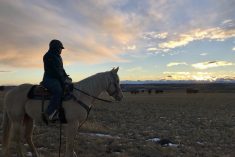Over the last couple of years there has been a lot of hype about mob grazing. I have seen a lot of articles about it and have been asked many questions about it. So I thought I would give my perspective of it.
For those of you who might be new to this term, mob grazing refers to the use of extremely high stock densities in your pasture management. In most cases, to achieve stock densities of 200 to 300 AD/acre will require you to move fence many times a day. For example, I mob grazed one area this spring and I moved fence six times a day. There can be some very positive results from this type of management as long as the basic grazing management concepts are still followed. First off, let’s review how any type of grazing needs to be managed in accordance with the four grazing concepts; graze period, rest period, stock density and animal impact.
Read Also

Reintroducing fire to Saskatchewan pastures
Pastures evolve over time. Woody plants and shrubs, which cattle can’t eat, may encroach on natural grasses. Invasive species, such…
Our goal with intensive cell grazing is to have our graze period short enough to stop the “second bite.” This means that the animals have to be removed from the paddock before the plants are able to put up another leaf after the first bite. Depending on your environment, this “second bite” could occur after only a few days in the fast growing season. If the plants are using stored energy from the roots to put up that new leaf, the root reserves will be empty when the second bite occurs and the plant will then be in a very weakened state.
With mob grazing, you are usually strip grazing down each paddock in the field and as long as you are off each paddock before this regrowth occurs, you will be fine.
Rest period also has to be managed in order to maintain a healthy, profitable pasture. Adequate rest has to be given to ensure the root reserves have been replenished before the plants are grazed for a second time. Again, depending on your environment and season, this could be anywhere from 25 days to 365 days.
Stock density is the number of animal units on a piece of land at a specific point in time. It is measured in animal days per acre. This is not to be confused with a stocking rate which is the number of animals you have on a pasture for the season. The benefit to a higher stock density is twofold; improved plant utilization and better manure distribution. If you have good plant utilization, every plant is either bitten or stepped on. This allows for an even playing field for every plant when it comes time to regrow. The higher the stock density, the better your manure distribution and the better your nutrient recycling will be. Mob grazing stock densities are very high and therefore do a very good job on both these points.
Animal impact is the physical stimulation of the land by the animals’ hooves. Animal impact can help with new seedling development, improve nutrient recycling, aid in breaking up capped soil and help change the state of forage transition. Positive animal impact can give you a tremendous improvement to the land as it will step a lot of litter into the ground. Many people see this as a “waste” of good grass but it can be surprising what this “waste” can do to improve the water-holding capacity and the fertility of the land. Mob grazing can cause many new species of plants to appear and it does a wonderful job of forage improvement.
If you are mob grazing and all of these concepts are followed, then you should have a very productive stand. However, I will offer you a warning. If mob grazing is practised during times of high rainfall, damage to the pasture can be severe. Be prepared to adjust your grazing during these periods. Animal nutrition is also a risk for the inexperienced mob grazer. How much and what quality of diet are your animals getting? It will take some trial and error to get your rations just right.
Now this is where the controversy arises and I apologize if I offend any experienced grazers out there. I do not practise mob grazing very often due to the extremely high labour costs associated with it. I only use it for short periods in certain areas if I need to. In all the magazine articles I have read on mob grazing, I have yet to see anyone pushing mob grazing show any accurate grazing costs which include labour and equipment. I usually only see numbers describing a “return to labour” value which does not account for the true costs associated with a grazing profit centre. This only calculates the gross revenue divided by the amount of time spent moving cattle.
In my environment, decent help comes with a price tag of about $20 per hour. Moving cattle six times a day pretty much uses up a full unit of labour. I do not get much else done when I am moving cattle six times a day. A full-time employee would cost me about $20,000 for four months. (Yes, you need to pay yourself if you are moving your own cattle.)
It will come down to the size of the herd and the cost of your labour to determine if mob grazing will work for you. Your costs will vary quite a bit depending on whether you walk out your back door to move fence or if you drive 20 miles to get to your pasture. Don’t forget to include the costs associated with that quad or pickup you’re driving. What about fencing costs and water system costs and spring setup costs and land costs… need I go on?
The biggest cost with mob grazing is usually the labour and equipment costs of everyday moves and monitoring of the cattle. If you graze for 120 days during the summer and you spend eight hours a day moving fences, that works out to $19,200 just for the employee. If that employee (or you) drives a quad, add another $25- $30 per hour on to that price tag to cover fuel, repairs, depreciation and opportunity cost on that equipment. That is another $24,000.
At $0.75 per head per day for a yearling, each animal I have on a pasture for those 120 days will make me $90. I will need 213 animals just to cover the labour of that employee, and another 266 animals for the equipment. I still have to cover all the other costs plus make a profit. How many more animals can you get on the land by moving six times a day compared to moving once a day or every second day? Is there that much improvement with mob grazing? Not on my ranch.
I see mob grazing being very beneficial in environments where labour is very cheap. If I had labour costs of $5 per day like some places do, my operation would be a lot different. Don’t get me wrong, I believe in the huge benefits you can get from high stock densities, and I do mob graze areas that need some improvement, but make sure the benefits outweigh the costs. I have other management techniques that can help improve my land that are more economical for me. Turn on your calculators. Can you make mob grazing pencil in your environment with your situation?
SteveKenyonrunsGreenerPasturesRanching
Ltd.inBusby,Alta., www.greenerpasturesranching.com, 780-307-6500,email
















